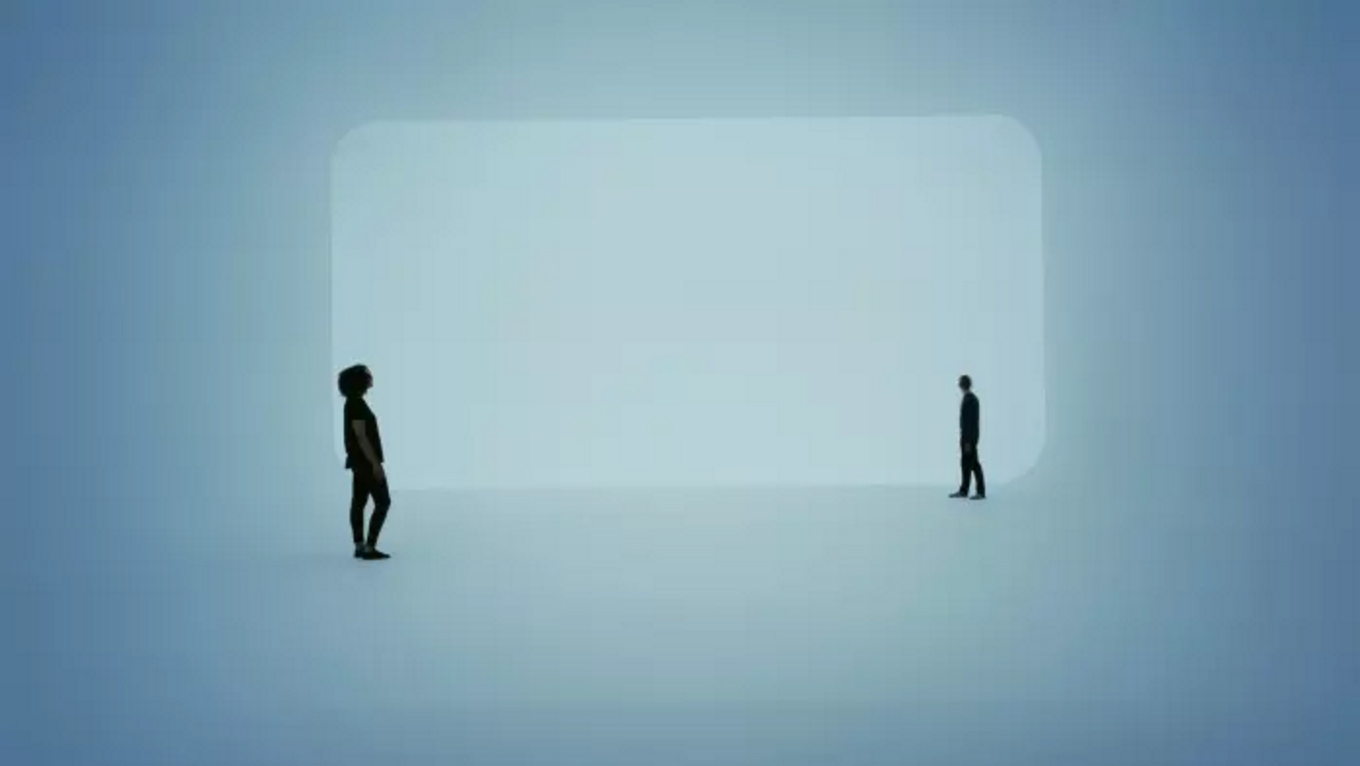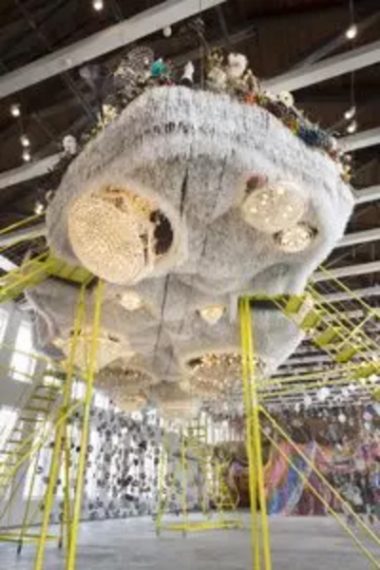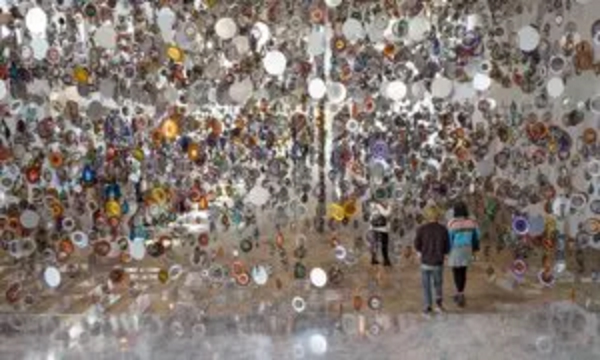The Massachusetts Museum of Contemporary Art has grown to become a contemporary art juggernaut
by Ariella Budick via ft.com

James Turrell’s ‘Perfectly Clear (Ganzfeld)’ (1991) © Florian Holzherr
As you hike the ever-expanding acreage of Mass MoCA, across high-ceilinged plateaus and through cavern-like rooms, over indoor bridges and down slot canyons vaulted with skylights, the landscape of contemporary art opens up in successive bursts of revelation. Here is a grove of steel-and-glass Rauschenbergs, there a mountainous block of marble carved by Louise Bourgeois, both a short distance from a glowing grotto designed by James Turrell. In the 18 years since Mass MoCA (the Massachusetts Museum of Contemporary Art) opened in an abandoned industrial complex in North Adams, Massachusetts, it has grown to engulf two dozen buildings and 250,000 sq ft of exhibition space, making it one of the world’s contemporary art juggernauts. Rather than crushing visitors with its hugeness, however, the museum delights them with playfulness.
In this rough-brick and salvaged-wood haven, young artists share space with their elders (and the recently deceased). Optimism, inventiveness and fertility abound, and most contributors are represented not by one or two pieces but by giant installations, series, even whole retrospectives. Each zone has its own integrity and vibe: the selection of Turrell’s meditative light environments makes a far more profound impression than the cluttered and crowded extravaganza at the Guggenheim in 2013. Jenny Holzer’s compendium of enlarged documents about the use of torture during the US invasion of Iraq — heavily redacted but still horrifying — has a mesmerising grimness. There is so much to take in that if one gallery doesn’t grab you, there’s always the next, or the one after that. Altogether, an exhaustive visit to Mass MoCA would now consume a well-spent weekend.

Nick Cave’s ‘Until’
The latest addition, Building 6, is a ship-shaped structure that plunges towards a fork in the much-abused Hoosic River, where the water’s hue once depended on what dyes the mills were dumping that day. Where the large-windowed walls converge to a prow, the architects at Bruner/Cott have carved out a grand double-height atrium where nature, industry and the arts all meet. After making your way along the twisting pathway through the rest of the museum, this feels like a sunny destination, a place of almost classical repose. Well, not quite repose: on the day I visited, a celebration of percussion sounds exploded from above.
Upstairs I found a group of musicians manhandling a collection of homemade instruments invented by Gunnar Schonbeck, one of the six artists whose work will inhabit Building 6 for the next 15 to 25 years. A professor at nearby Bennington College until his death in 2005, Schonbeck fashioned an orchestra out of packing crates, wire, auto springs, floorboards, oil drums and whatever else his local dump might yield.
One part of the exhibition treats the contraptions as do-not-touch art objects (unless authorised specialists are present to demonstrate), but two soundproofed galleries contain selections from his instrumentarium that visitors can pluck, pound and stroke at will. In a sense, this show, No Experience Required, acts as a microcosm for the entire institution. Irreverent, startling and deceptively crude, it is also focused on the profound message that art can spring from anywhere and speak to anyone.
Work like Schonbeck’s makes Mass MoCA an utterly un-snobbish art museum, irresistible to neophytes of every age. Laurie Anderson (another long-term tenant of Building 6) presents “Handphone Table”, a wired wooden farm table where visitors sit, place their elbows in polished hollows and their hands over their ears, and feel a sequence of musical roars and clicks rumbling through their bones. In the vast, hangar-like space of Building 5, Nick Cave leads visitors through a rain of dangling, shimmering lawn ornaments, then up a ladder to a canopy of chandeliers and a cloud of ceramic birds, fake flowers, metallic pigs and racist lawn jockeys.

Nick Cave’s ‘Until’
Cave’s installation proves that pleasure and reflection need not be mutually exclusive, just as profundity doesn’t always come in pills that are hard to swallow. Some will enjoy the sheer cornucopia of shiny things; others will pause to absorb the open-ended meanings secreted in “Until”. History is an accumulation of appalling memories, each with its own sedimentary deposit of artefacts and memorabilia. Cave recycles the tchotchkes of bigotry, turning them into a great glittering tent. “Until” is a shelter beneath which we can all conduct America’s most urgent conversations.
Mass MoCA has no permanent collection but the art in its short- and long-term loans covers an astonishing range of materials and technology, from pure white light to 20-ton stones, from scraps of rusted metal to high-tech creations. The brilliant Louisiana artist Dawn DeDeaux pays homage to Rauschenberg, and to our frail and damaged planet, by assembling charred wood and evocative bric-a-brac (“an alligator-skin book of Longfellow poems”, a “tape measure stuck on 1”). And even as she forages for relics of our time on Earth, she imagines the fashions of space travel in intricate, wall-sized digital drawings.
Elizabeth King asks ever-timely questions about what makes us human in an exhibition called Radical Small. Her sculpted limbs, eyes and faces combine the eerily realistic with the obviously mechanical, producing automatons that remain trapped in their cases yet also look so expressive that you expect to see one shed a tear.
We have low costs, good will, and a little salutary remoteness to thank for Mass MoCA’s generous scoops of excitement. The bill to renovate Building 6 and fill it with art, plus extra for the endowment, came to $55m, which sounds like a lot until you consider that the Whitney Museum of American Art spends nearly that much in operating costs every year. The forgiving economics of a rural mill town mean that, instead of artworks and visitors cramming into every available nook, as they must in most New York City museums, here people and objects can spread out.

Louise Bourgeois, ‘The Couple’ (2007-09)
It’s true that you need to reserve time slots (which can fill up) to enter Anderson’s virtual reality room or Turrell’s immersive “Ganzfeld”. But they are exceptions. For the most part, each work is cushioned by plenty of light and air. Bourgeois’s “The Couple”, two entwined lovers made of polished aluminium, hangs from the ceiling. Wrapped in endless, looping limbs, they form a single creature, Adam and Eve fused with the offending snake, their solitude magnified by the architecture’s accidental cage of wooden beams, weathered columns and gridded windows. Sure, people could crowd around and snap selfies, but most maintain a decorous distance, unwilling to intrude on such all-consuming intimacy.
Mass MoCA is the rare museum where the experience of art is so persistently surprising, intensely theatrical and fun.
